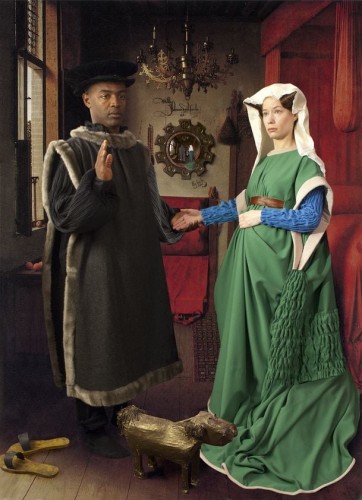
Photography and acting are kindred spirits in this ongoing series by E2 – Kleinveld & Julien. Entitled In Empathy We Trust, the project presents viewers with re-imagined iconic images from the history of art. The collaborators re-envisioned the work of old master painters beginning with the Flemish Primitives and spanning nearly 600 years.
With subjects enacting roles with varied representations of race, age, and sexual orientation, E2 revisionist Art History works by artists such as van Eyck, Rafael, Velázquez, Rembrandt, Vermeer, Fragonard, and Manet. Inspired by the original paintings, E2 hopes to “jar viewers” into questioning their own perceptions. They invite viewers to see these images, and indeed the world anew, using humor, wit and playfulness. In addition, they hope that the viewers will see how stereotypes can lead to prejudice and discrimination.
The collaboration began in 2010, after completing work on the traveling exhibition and book project, Before (During) After: Louisiana Photographers Respond to Hurricane Katrina. This natural and man-made disaster brought social inequities in Louisiana into vivid focus. Conversations between Kleinveld and Julien revealed their mutual interest in issues of social justice.
Elizabeth Kleinveld is an artist and photographer from New Orleans, now based in Amsterdam, who takes her inspiration from Paul Outerbridge: “Art is life seen through man’s craving for perfection and beauty.” For her, art is about creative self-expression and storytelling, allowing her to respond to what she observes in the world. While some of her work is about striving to express the beauty she sees, other work focuses on themes she finds politically important. Often, she uses art to transform her reality as she did in 2007, while working to come to terms with the aftermath of Hurricane Katrina.
Epaul Julien is an artist from New Orleans who began his career as a fine art photographer in 1995 when a near death experience changed his life. Creating art for him is a necessity, vitally linked to his existence. His method has also been shaped by the extremity of his circumstances. When the floodwaters of Hurricane Katrina forced him to abandon his darkroom and bulky photographic equipment, he emerged with a new approach; six months of exile pushed him to use the images he had salvaged and to create a new form of mixed media.